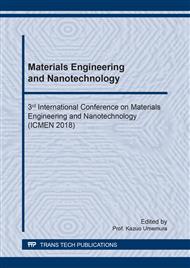p.42
p.47
p.53
p.58
p.63
p.71
p.77
p.82
p.88
Deposition of Sorption and Photocatalytic Material on Nanofibers and Fabric by Controlled Sublimation
Abstract:
This paper presents a new method of deposition of photocatalytic sorbent on nanofibers. This deposition uses controlled sublimation of water molecules from the vacuum-gel that is patent-protected. Silica gel nanostructures are precipitated by heterogeneous nucleation on the surface of nanofibres from an aqueous suspension of silicate nanoparticles and semiconductor carbon nitride (C3N4 ) or graphene nanosheets. After rapid solidification of gel (at least 104 K/s), the nanofibers coated with the silica gel dispersion C3N4, or graphene are subjected to controlled sublimation at – 41 °C. This technology produced a nanofibrous material, which is stably coated with a highly porous silicate sorbent including dispersed photocatalytic nanoparticles. This textile material has a total sorption surface area of the order of hundreds m2/g. Unlike conventional sorbents, it is capable due to dispersed photocatalytic nanoparticles to regenerate sorption capacity by the absorption of visible light. The results of the preliminary research confirmed the high application potential of new controlled sublimation technology in the production of regenerable photocatalytic sorption fabrics.
Info:
Periodical:
Pages:
63-67
Citation:
Online since:
October 2018
Price:
Сopyright:
© 2018 Trans Tech Publications Ltd. All Rights Reserved
Share:
Citation:


